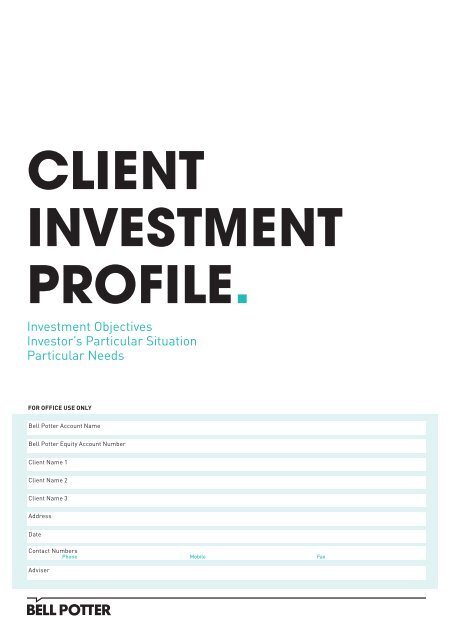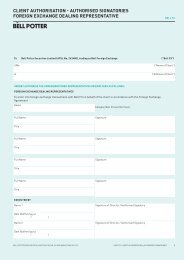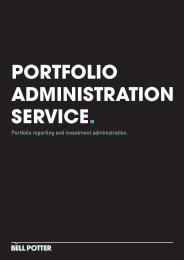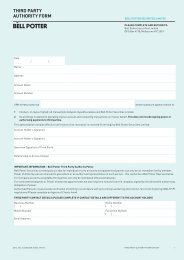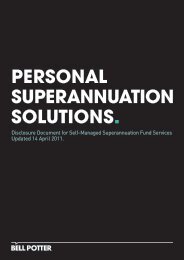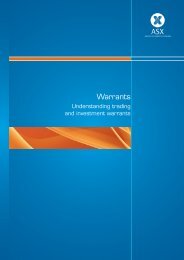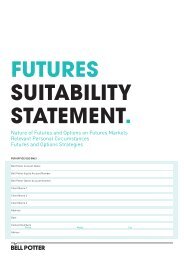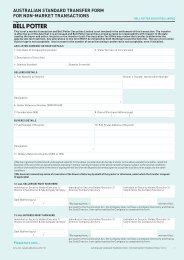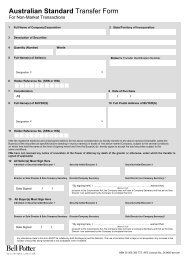investment objectives - Bell Potter Securities
investment objectives - Bell Potter Securities
investment objectives - Bell Potter Securities
You also want an ePaper? Increase the reach of your titles
YUMPU automatically turns print PDFs into web optimized ePapers that Google loves.
client<strong>investment</strong>profile.Investment ObjectivesInvestor’s Particular SituationParticular NeedsFOR OFFICE USE ONLY<strong>Bell</strong> <strong>Potter</strong> Account Name<strong>Bell</strong> <strong>Potter</strong> Equity Account NumberClient Name 1Client Name 2Client Name 3AddressDateContact NumbersPhone Mobile FaxAdviser
explanation of alternative<strong>investment</strong> <strong>objectives</strong>.LOW CAPITAL RISKDescriptionRisk and VolatilitySuitabilityINCOMEDescriptionRisk and VolatilitySuitabilityBALANCEDDescriptionRisk and VolatilitySuitabilityGROWTHDescriptionRisk and VolatilitySuitabilityThe primary objective is preservation of capital. Depending on the requirements of the Investor,this can be accompanied by a high degree of liquidity. The portfolio would contain fixed incomesecurities from AAA institutions. Such an <strong>investment</strong> is usually associated with a dependable,ongoing income stream and its associated low volatility of returns. However, the after-taxreturns may be very low and may not keep pace with inflation. Capital risk could arise if therewas a mismatch between the Investor’s time frame and the actual term of the <strong>investment</strong>. This<strong>investment</strong> is not generally compatible with investing in stock exchange listed equities. To pursuethis <strong>investment</strong> objective in listed equities, it would be necessary to first hold shares in largeand well established market leaders having a record of low volatility of returns from regular wellcovered dividends, and second accept a higher, albeit still a relatively low, degree of risk.Only prepared to accept minimal capital risk and volatility of <strong>investment</strong> returns.A strongly conservative Investor who is prepared to accept lower returns for the <strong>investment</strong> to beprotected ie. Interest Rate Products. The adverse effects of inflation and tax are not a concern.Here the <strong>objectives</strong> are the preservation of capital and the generation of income. This objectiveaims to generate a total return of a couple of points better than CPI. Over the medium to longterm,this objective aims to provide some minimal volatility of <strong>investment</strong> returns, while aiming topreserve capital. However, to the extent that hybrid securities such as reset preference shares,income securities and convertible notes, and equity shares are included in the portfolio, highercapital risk and volatility will be incurred.Subject to the abovementioned comment regarding hybrid securities and equity shares, there isbelow- average capital risk and volatility of <strong>investment</strong> returns.The Investor who is looking for better than a basic return but only within a low capital risk. TheInvestor will be seeking to enhance returns from a diversified portfolio of interest rate products,hybrid securities and a limited <strong>investment</strong> in equities and/or property trusts.The objective is to achieve returns from a mix of all or some of Interest Rate, Property and EquityAsset Classes, which have regard for both Interest Rate and Capital Gain. Investors with privateproperty holdings may elect to pursue a Balanced Investment Objective with either a mix ofInterest Rate and Equity Asset Classes or, within the Equity Asset Class alone utilising equitieshaving income or growth characteristics, or a combination of bothAs growth assets will always form part of the portfolio, there is a preparedness to accept somecapital risk. Investment returns will fluctuate over the short term, including the possibility of anegative return in some periods. It is a medium to high-risk <strong>investment</strong> and should be viewed overat least a 3 to 5 year period.This Investor is looking for a balanced portfolio of diversified <strong>investment</strong>s providing someprotection against both taxation and inflation. The long-term average exposure to growth andincome assets is expected to be approximately 65% and 35% respectively of the total portfolio,although this could vary in the short-term.A more aggressive <strong>investment</strong> strategy than for Balanced is used with more exposure to growthassets over a slightly longer time frame of, say, 5 years or more.Above-average capital risk and volatility of returns in the short-term, in order to take advantage ofthe opportunities for superior portfolio performance in the medium to long term.This Investor is prepared to accept capital risk and volatility of returns in the short-term, in orderto take advantage of the opportunities for superior portfolio performance in the medium to longterm.Client Investment Profile V0909153
explanation of alternative<strong>investment</strong> <strong>objectives</strong>(Continued . . .)AGGRESSIVE GROWTHDescriptionRisk and VolatilitySuitabilityTRADINGDescriptionRisk and VolatilitySuitabilitySPECULATIVEDescriptionRisk and VolatilitySuitabilityLEVERAGEDescriptionRisk and VolatilitySuitabilityA preparedness to compromise portfolio balance further in the expectation of higher long-termgains, to include small cap stocks, cyclical stocks and stocks with past volatile performance, and toinvest with the sole objective of maximising <strong>investment</strong> performance over a wide range of stocks interms of size, past performance and volatility of returns.The security of capital is secondary to the potential for wealth creation. A diverse range of<strong>investment</strong>s will carry a high level of risk and volatility of returns over 7 years or more.This Investor is pursuing high growth <strong>investment</strong> returns and accepts capital risk and highvolatility of returns.A Trading Objective evidences a preparedness to invest for the short-term to realise primarilycapital gains on stocks. This approach to <strong>investment</strong> is based on identifying <strong>investment</strong>opportunities, which are valued at a discount to what is perceived by the Investor as being theintrinsic value of the stock. Alternatively, it could involve buy and sell decisions based on theoccurrence of technical indicators.A very high level of capital risk and volatility of returns as gains will be dependent upon not onlyidentifying undervalued situations but anticipating a revaluation by the market.The Investor with a Trading Objective will be experienced, prepared to take a contrarian view to themarket and accept the associated risks, and be closely associated with the design of the strategy.Speculative <strong>investment</strong>s are either start-up enterprises with nil or only prospective operationsor recently commenced operations, with only forecast cashflows or those that have commencedoperations but have very limited cashflows and/or a stressed balance sheet.Speculative<strong>investment</strong>s also encompass derivative <strong>investment</strong>s other than derivatives undertaken for purehedging purposes.An exceptionally high level of capital risk and volatility of returns.Only experienced Investors with capital surplus to living and <strong>investment</strong> requirements, who areprepared to accept the high degree of risk associated with either a complete absence of trackrecord or an unfavourable track record an d the exclusive reliance on forecasting. The Investor willneed to have a clear understanding of the basis underlying this kind of <strong>investment</strong>.Leverage can be obtained by a variety of instruments, either through Options, Warrants, CFDsor by means of a Margin Lending facility. Options, Warrants and CFDs are forms of Derivatives –they have underlying securities. All can be used for very different purposes and as a result havea very wide spectrum of risks, <strong>investment</strong> <strong>objectives</strong> and likely returns. All provide leverage andthe potential to make a higher return from a smaller initial outlay than investing directly in theunderlying security. They can be used to manage risk, to speculate, to diversify and to generateincome, albeit with associated risks.A Margin Lending facility involves gearing an <strong>investment</strong> byobtaining a line of credit by borrowing between 35% to 80% of the value of the <strong>investment</strong>. Thefacility is available in relation to approximately 1000 approved listed shares and managed funds.The repayment of the facility is secured by the shares/managed funds and the margining of pricefalls below the agreed lending ratio.Capital risk can vary greatly from a fixed premium for taken/bought Put and Call Options tounlimited capital risk on uncovered written Option strategies. All Derivatives are subject to marketrisk of the underlying security or Index. Options are wasting assets, as they suffer time decay asthey move toward expiry. Because Options are leveraged, a small movement in the underlyingsecurity can have a proportionately larger impact on the value of the option.Margin Lendingfacilities also entail an increased exposure to volatility and can magnify potential losses. Inaddition to an increased exposure to the sharemarket, an interest rate risk also exists.Leverage is not suitable for some Retail Investors. It is only suitable for those experiencedInvestors who are fully aware of the extent of both the risks and rewards - sometimes limitedrewards and substantial and unlimited risk and, in the case of Margin Lending facilities, thefunding and repayment obligations.4
<strong>investment</strong> <strong>objectives</strong>.Tick () ONE Primary Investment Objective.It is optional to also tick () ONE Secondary Objective and, if appropriate, tick () another ONE Objective in which you may beInterested.Investors should understand that all equity <strong>investment</strong>s involve some capital risk. The selection of the Low Capital Risk InvestmentObjective precludes the selection of any other Primary, Secondary or Interested Investment Objectives.Low Capital RiskIncomeBalanceGrowthAggressive GrowthTradingSpeculativeLeveraged Income or GrowthPrimary Secondary InterestedClient Investment Profile V090915 5
investor’s financial situationTO BE COMPLETED BYINDIVIDUAL INVESTORS1. Planned Retirement 2. Family Income Earner & DependantsRetirement year Are you the sole family income earner? Yes NoAge Under 21 Number of dependants21 -3536 - 5051 - 65Over 653. Employment 4. Primary Source of IncomeHow would you categorise your employment?PermanentCasual/Part TimeSelf EmployedRetiredHome DutiesWhat is your primary source of income?BusinessSalaryInvestmentsRetirement AssetsPensionOther5. Current <strong>Securities</strong> Investments 6. Current Reliance on Investment IncomeWhat is the approximate value of your <strong>Securities</strong> Portfolio?$What is the approximate percentage that your%<strong>Securities</strong> Portfolio represents of your total networth?Date of Valuation of your <strong>Securities</strong> PortfolioDo you propose to increase the size of your <strong>Securities</strong>Portfolio from other assets?No If Yes, proposed additional securities <strong>investment</strong>.To what extent do you rely on the income from your <strong>Securities</strong>Portfolio for living expenses?EntirelySubstantiallyPartiallyNot at all7. Future Reliance on Investment Income 8. Tax PositionWhen do you expect to rely either entirely or substantiallyon the <strong>investment</strong> income from your <strong>Securities</strong> Portfolio What is your annual income before tax?for your living expenses?Currently reliant $0 - $30,000Less than 2 years $30,001 - $60,0002 – 4 years $60,001 - $150,0005 – 7 years $150,001 - $250,000More than 7 years Over $250,0016
9. GearingWhat percentage of your <strong>Securities</strong> Portfolio is borrowed, whetherby means of a Bank Overdraft, a Margin Lending facility or otherloan arrangement?NoneLess than 25%25% – 50%More than 50%Do you need income from your <strong>Securities</strong> trading to meet interestcommitments?YesNoAre your <strong>Securities</strong> borrowings against your family home? Yes No10. SuperannuationDo you have any superannuation arrangements? If Yes, what is thenature of your superannuation?Public (Commonwealth, State or Municipal)CorporatePrivate (SMSF or APRA Regulated Fund)Other (please specify)11. Trustee(s) of Superannuation Funds*YesNoDo you have a written Investment Strategy? Yes NoIf YES, does it include <strong>investment</strong>s in <strong>Securities</strong>? Yes NoIf YES, are there any specific limitations on the <strong>investment</strong>s in<strong>Securities</strong>?If YES, what are those limitations?YesNo*If you wish to open an SMSF account with <strong>Bell</strong> <strong>Potter</strong> <strong>Securities</strong>, please complete the relevant SMSF ClientInvestment ProfileClient Investment Profile V090915Client Investment Profile V090915 77
investor’s financial situation (Continued . . .)TO BE COMPLETED BYCORPORATE INVESTORS1. Certificate of IncorporationDate of Incorporation / /Copy of Certificate of Incorporation attached? Yes NoIf NO, please quote ABN / ACN2. Asset AllocationAsset classes in which the Company has current assets:Asset Class Current Asset Class CurrentDeposits $ Property $Listed <strong>Securities</strong> $ International <strong>Securities</strong> $Unlisted <strong>Securities</strong> $ Business Assets $Mortgages $ Other $3. ActivitiesManufacturingInvestmentTradingServicesTrusteeOther (please specify)4. DirectorsAre you the Sole Director? Yes NoIf NO, please list the other Directors?Are the shareholders dependent on dividends paid out of income generated by the Company? Yes NoFrom its listed securities, does the Company propose to generate income from:Dividends or Interest Trading Profits Combination of both5. Current <strong>Securities</strong> InvestmentsWhat is the approximate value of the Company’s listed securities portfolio?$What is the approximate percentage that the listed securities portfolio represents the Company’s total net worth?%6. GearingWhat percentage of the Company’s listed securities portfolio is borrowed, whether by means of a Bank Overdraft, a MarginLending Facility or other loan arrangement?None 25% – 50%Less than 25% More than 50%Is income from <strong>Securities</strong> trading required to meet the Company’s portfolio interest commitments? Yes NoDo you intend to gear your portfolio? Yes NoIf so, to what level?%8
INVESTMENT EXPERIENCE AND TIME HORIZONTO BE COMPLETED BYall INVESTORS1. Past Investments and Investment ExperienceWhat asset classes have you invested in, in the past and what has been the extent of your experience in investing in these assetclasses?Fixed InterestProperty TrustsManaged FundsAustralian EquitiesInternational EquitiesOptions / WarrantsMargin LendingOther (please specify)Extensive Moderate Limited None2. Time HorizonWhat is the time horizon of your securities <strong>investment</strong>s (ie. for what period are you wanting to invest)?Less than 18 months18 months – 3 years3 years – 5 years5 years – 7 yearsMore than 7 yearsClient Investment Profile V090915Client Investment Profile V090915 99
PARTICULAR NEEDS (CONTINUED . . .)If you have any particular needs not covered (eg. sectors in which you don’t want to invest), please summarise them below.confirmation of personal informationI/ We confirm my/our understanding of the foregoing and I/we warrant that the information provided is complete and correctand can be relied upon.Client Name 1SignatureDateClient Name 2SignatureDateClient Name 3SignatureDateAdviser NameAdviser SignatureDateClient Investment Profile V090915Client Investment Profile V090915 1111
<strong>Bell</strong> <strong>Potter</strong><strong>Securities</strong> LimitedGPO Box 4718,Melbourne VIC 3001,AustraliaToll Free 1800 804 816Fax 03 9256 8787www.bellpotter.com.auABN 25 006 390 772AFS Licence No. 243480


